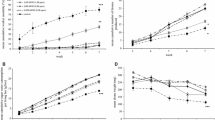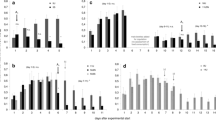Abstract
Kaolin is an inert material with a broad range of applications, e.g. as an insecticide and as a filling substance in the formulation of biopesticides. Hence, bees that dispense biopesticides to the field in the context of entomovectoring are exposed to elevated risks because of side-effects of those products. Here, we investigated with use of bumble bee workers of Bombus terrestris L. the lethal and sublethal effects of (i) pure kaolin, (ii) the biofungicide Prestop-Mix containing the parasitic fungus Gliocladium catenulatum and kaolin and (iii) the bioinsecticide BotaniGard containing the entomopathogenic fungus Beauveria bassiana and compared with wheat flour powder that we considered safe for bumble bees. As the most important result, treatment with kaolin increased the cuticular water loss and reduced the survival of treated bumble bees, while Prestop-Mix had no negative effect on longevity. BotaniGard caused mortality in the bumble bees because of the entomopathogenic spores it contained. In conclusion, our data indicated that substances used as ‘inert materials’ and in biocontrol agents which are used in IPM and organic farming systems may bring higher risks to bumble bees used in entomovector technology.


Similar content being viewed by others
References
Al-Mazra’Awi MS, Shipp JL, Broadbent AB, Kevan PG (2007) Biological control of Lygus lineolaris (Hemiptera: Miridae) and Frankliniella occidentalis (Thysanoptera: Thripidae) by Bombus impatiens (Hymenoptera: Apidae) vectored Beauveria bassiana in greenhouse sweet pepper. Biol Control 37:89–97
Amnuaykanjanasin A, Jirakkakul J, Panyasiri C, Panyarakkit P, Nounurai P, Chantasingh D, Eurwilaichitr L, Cheevadhanarak S, Tanticharoen M (2013) Infection and colonization of tissues of the aphid Myzus persicae and cassava mealybug Phenacoccus manihoti by the fungus Beauveria bassiana. BioControl 58:379–391
Bryden J, Gill RJ, Mitton RAA, Raine NE, Jansen VAA (2013) Chronic sublethal stress causes bee colony failure. Ecol Lett 16:1463–1469
Cook DA, Wakefield ME, Bryning GP (2008) The physical action of three diatomaceous earths against the cuticle of the flour mite Acarus siro L. (Acari: Acaridae). Pest Manag Sci 64:141–146
Ebeling W (1971) Sorptive dusts for pest control. Annu Rev Entomol 16:123–158
EFSA (2013) EFSA Guidance Document on the Risk Assessment of Plant Protection Products on Bees (Apis mellifera, Bombus spp. and solitary bees). EFSA Journal 11(7):3295 http://www.efsa.europa.eu/en/search/doc/3295.pdf
Fargues J, Goettel MS, Smits N, Ouedraogo A, Rougier M (1997) Effect of temperature on vegetative growth of Beauveria bassiana isolates from different origins. Mycologia 89:383–392
Gibbs AG, Johnson RA (2004) The role of discontinuous gas in insects: the chthonic hypothesis does not hold water. J Exp Biol 207:3477–3482
Glenn DM, Puterka G (2005) Particle films: a new technology for agriculture. Hortic Rev 31:1–44
Glenn DM, Puterka GJ, Vanderzwet T, Byers RE, Feldhake C (1999) Hydrophobic particle films: a new paradigm for suppression of arthropod pests and plant diseases. J Econ Entomol 92:759–771
Golob P (1997) Current status and future perspectives for inert dusts for control of stored product insects. J Stored Prod Res 33:69–79
Hokkanen H, Menzler-Hokkanen I (2009) Successful use of honey bees for grey mould biocontrol on strawberries and raspberries in Finland. Apidologie 40:659
Israel MS, Boland GJ (1992) Influence of formulation on efficacy of honey bees to transmit biological controls for management of sclerotinia stem rot of canola. Can J Plant Pathol 14:240–249
Karise R, Kuusik A, Mänd M, Metspalu L, Williams IH, Hiiesaar K, Luik A, Muljar R, Liiv K (2010) Gas exchange patterns of bumble bee foragers before and after exposing to lowered temperature. J Insect Physiol 56:529–535
Kestler P (1985) Respiration and respiratory water loss. In: Hoffmann KH (ed) Environmental Physiology and Biochemistry of Insects. Springer-Verlag, Berlin, pp 137–189
Kestler P (1991) Cyclic CO2 release as a physiological stress indicator in insects. Comp Biochem Physiol C 100:207–211
Kljajić P, Andrić G, Adamović M, Bodroža-Solarov M, Marković M, Perić I (2010) Laboratory assessment of insecticidal effectiveness of natural zeolite and diatomaceous earth formulations against three stored-product beetle pests. J Stored Prod Res 46:1–6
Mänd M, Kuusik A, Martin AJ, Williams IH, Luik A, Karise R, Metspalu L, Hiiesaar K (2005) Discontinuous gas exchange cycles and active ventilation in pupae of the bumble bee Bombus terrestris. Apidologie 36:561–570
Mänd M, Williams IH, Viik E, Karise R (2010) Oilseed rape, bees and integrated pest management. In: Williams IH (ed) Biocontrol-based integrated management of oilseed rape pests. Springer Science, New York, pp 357–379
Markó V, Blommers LHM, Bogya S, Helsen H (2008) Kaolin particle films suppress many apple pests, disrupt natural enemies and promote woolly apple aphid. J Appl Entomol 132:26–35
Mikami AY, Pissinati A, Fagotti D, de Oliveira Menezes Junior A, Ventura MU (2010) Control of the Mexican bean weevil Zabrotes subfasciatus with kaolin. Ciência Rural 40:1497–1501
Mommaerts V, Smagghe G (2011) Entomovectoring in plant protection. Arthropod-Plant Interac 5:81–95
Mommaerts V, Sterk G, Hoffmann L, Smagghe G (2009) Assessment of compatibility of microbiological control agents with the pollinator Bombus terrestris. Pest Manag Sci 65:949–955
Mommaerts V, Put K, Smagghe G (2011) Bombus terrestris as pollinator-and-vector to suppress Botrytis cinerea in greenhouse strawberry. Pest Manag Sci 67:1069–1075
Mommaerts V, Put K, Vandeven J, Smagghe G (2012) Miniature-dispenser-based bioassay to evaluate the compatibility of powder formulations used in an entomovectoring approach. Pest Manag Sci 68:922–927
Muljar R, Karise R, Viik E, Kuusik A, Williams IH, Metspalu L, Hiiesaar K, Must A, Luik A, Mänd M (2012) Effects of Fastac 50 EC on bumble bee Bombus terrestris L. respiration: DGE disappearance does not lead to increasing water loss. J Insect Physiol 58:1469–1476
Muncha-Pelzer T, Bauer R, Scobel E, Ulrichs C (2010) Insecticidal effect of different application techniques for silica dusts in plant protection on Phaedon cochleariae Fab. and Pieris brassicae L. HortScience 45:1349–1356
Peng G, Sutton JC, Kevan PG (1992) Effectiveness of honeybees for applying the biocontrol agent Gliocladium roseum to strawberry flowers to suppress Botrytis cinerea. Can J Plant Pathol 14:117–129
Rosa CA, Lachance MA, Silva JO, Teixeira AC, Marini MM, Antonini Y, Martins RP (2003) Yeast communities associated with stingless bees. FEMS Yeast Res 4:271–275
Schimpf NG, Matthews PGD, White CR (2013) Discontinuous gas exchange exhibition is a heritable trait in speckled cockroaches Nauphoeta cinerea. J Evol Biol 26:1588–1597
Shipp L, Kapongo JP, Park HH, Kevan P (2012) Effect of bee-vectored Beauveria bassiana on greenhouse beneficials under greenhouse cage conditions. Biol Control 63:135–142
Smagghe G, Mommaerts V, Hokkanen H, Menzler-Hokkanen I (2012) Multitrophic interactions: the entomovector technology. In: Smagghe G, Diaz I (eds) Arthropod-plant interactions: novel insights and approaches for IPM, progress in biological control. Springer, New York-London, pp 127–157
Subramanyam Bh, Roesli R (2000) Inert dusts. In: Subramanyam Bh, Hagstrum DW (eds) Alternatives to pesticides in stored-product IPM. Kluwer Academic Publishers, Dordrecht, pp 321–380
Ucar T, Ozkan HE, Fox RD, Brazee RD, Derksen RC (1999) Criteria and procedures for evaluation of solids mixing in agricultural sprayer tanks. Trans ASAE 42:1581–1587
Van der Steen JJM, Langerak CJ, Van Tongeren CAM, Dik AJ (2003) Aspects of the use of honeybees and bumble bees as vector of antagonistic micro-organisms in plant disease control. In: Bruin J (ed) Proc Netherlands Entomol Soc Meeting. Uitgeverij Nederlandse Entomologische Vereniging, Amsterdam, pp 41–46
Velthuis HHW, van Doorn A (2006) A century of advances in bumblebee domestication and the economic and environmental aspects of its commercialization for pollination. Apidologie 37:421–451
Yamoah E, Jones EE, Weld RJ, Suckling DM, Waipara N, Bourdôt GW, Hee AKW, Stewart A (2008) Microbial population and diversity on the exoskeletons of four insect species associated with gorse (Ulex europaeus L.). Aust J Entomol 47:370–379
Yoon HJ, Kim SE, Kim YS (2002) Temperature and humidity favorable for colony development of the indoor-reared bumble bee, Bombus ignitus. Appl Entomol Zool 37:419–423
Zafeiridou G, Theophilidis G (2006) A simple method for monitoring the respiratory rhythm in intact insects and assessing the neurotoxicity of insecticides. Pestic Biochem Physiol 86:211–217
Acknowledgments
This research was supported by target financing (SF0170057s09) and institutional research funding (IUT36-2) of the Estonian Ministry of Education and Estonian Science Foundation Grants No. 9450, EU-ERANET activity of the CORE Organic Programme II project BICOPOLL, Estonian Ministry of Agriculture Applied Research project No. T13055PKTK.
Author information
Authors and Affiliations
Corresponding author
Additional information
Communicated by C. Cutler.
Rights and permissions
About this article
Cite this article
Karise, R., Muljar, R., Smagghe, G. et al. Sublethal effects of kaolin and the biopesticides Prestop-Mix and BotaniGard on metabolic rate, water loss and longevity in bumble bees (Bombus terrestris). J Pest Sci 89, 171–178 (2016). https://doi.org/10.1007/s10340-015-0649-z
Received:
Revised:
Accepted:
Published:
Issue Date:
DOI: https://doi.org/10.1007/s10340-015-0649-z




